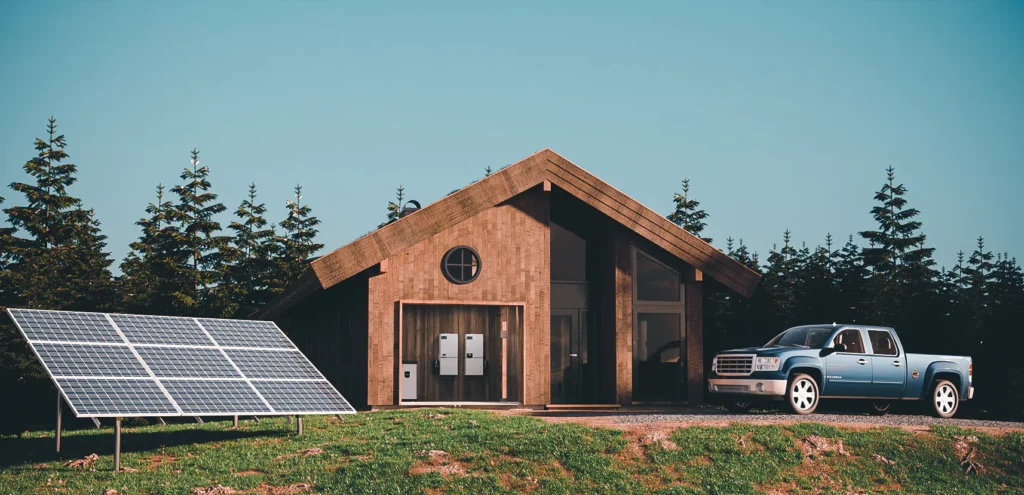Many people choose solar power because they want true energy independence.
While going solar does mean reducing your monthly energy bills and carbon footprint, it doesn’t mean you are free from the utility companies just yet.
Regular solar systems are connected to the energy grid managed by the utility companies. This allows you to pull extra energy when you need it and push back extra energy produced by your system to earn energy credits when you don’t. This is called “Net Metering” and makes solar energy systems very financially attractive.
In order to truly disconnect from the grid you would need to add or include solar batteries in your solar energy system. Standard solar energy systems do not include batteries as they can be quite expensive and most solar users are content to be connected to the grid. By being connected to the grid you can sell the extra energy back to the utility company. When you are “off the grid” you lose that ability and all the benefits that come with it.
There are additional benefits to owning solar batteries besides being “off the grid,” such as keeping your home powered when there are power outages. You can even pull energy from the battery at night when it’s dark out, rather than relying on the grid, before topping it back off the following day. It’s commonly referred to as “energy resilience” when you start to reduce your reliance on energy from the grid.
California also offers the Self-Generation Incentive Program (SGIP), which is built to encourage energy storage (i.e. solar batteries). There is an excess of solar power in California to the point where the state can’t use it all. California will even pay other states to take excess power so as to not overload the grid. However, when the sun goes down and there is no more solar power the system relies on traditional energy sources (such as gas-powered plants), which is why utility companies charge more for electricity in the evening. The utility companies will help subsidize your solar battery to reduce off-hour energy production costs.
The SGIP is not a fixed rebate, you will get a fixed amount of money per kWh of storage depending on the current rate in flux. This process can be very complex and take significant time to see a return. Your installer will need to file the paperwork and it can take up to a year to get your subsidy.
It’s important to know a few things before planning to go “off-the-grid”:
- Your Entire House Might Not Be Able To Run On Just A Solar Battery – Unless your system produces and stores massive amounts of energy, you’ll have to be selective about what to power. During dark hours or a blackout you might only be able to draw power to selective circuits, such as the refrigerator, wireless router, etc.
- Battery Charging Reduces in Fall And Winter – When there is an overabundance of sun, there is an overabundance of solar. During Spring and Summer, it is standard for solar batteries to be fully charged by the middle of the day. But in Fall and Winter it’s not uncommon for batteries to not reach a full recharge at all, especially if it’s cloudy out.
Adding solar batteries will significantly increase the price of your solar system, so your expected payback period will be far longer. And since you aren’t connected to the grid, you can’t participate in Net Metering and earn energy credits, which will further reduce savings.
There is a real price to pay for going “off the grid” and the cost is passed on to you mostly. Solar users typically only get systems built to go “off the grid” if their property is too remote for grid connectivity. If the closest network transmission lines are far away it might be more expensive to get connected to the grid than to get a solar system with batteries that can support your home without it.
At Sunline we believe that solar batteries are a great way to protect your home from blackouts and leverage Net Metering to its max potential (since you can feed energy back to the grid when you earn the most and use what’s stored when it costs the most).
You won’t be “off the grid” and have true energy independence. You’ll still have to deal with SDG&E or another local utility company. But currently the trade-off is more than worth it, and most of our customers feel the same. It might sound great to be “energy independent,” but to many it sounds far better to receive electric bills where you owe next to nothing.
Contact Sunline Energy today to learn more about adding solar batteries to your existing system or building a system that allows you to go off the grid. We’re the highest-rated solar company in San Diego on Yelp because we treat every customer like family. We look forward to discussing your solar dreams and figuring out a plan to make them a reality.


